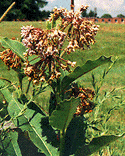

 |
As caterpillars, monarchs utilize, ingest, and store up the toxic glycoside which is present in the adults. The predators of these butterflies, insectivorous birds, find the butterflies distasteful and poisonous because of the toxic chemicals. Monarchs also have bright warning colors as part of their defense mechanism to deter predators. Orange is used as a warning color because it is clearly distinguishable. |
What do monarch caterpillars eat?
| Milkweed plants produce a white sap which contains cardiac gylcoside that acts as a deterrent to most herbivores. This substance is called a "secondary substance" because they are toxic, bad tasting, or both and thus deter predation. However, some species of insects, including monarchs, are able to feed on the milkweeds without being poisoned because of the evolved enzymes that they carry. Swamp milkweed and common milkweed are the most common foods for monarch caterpillars. |

|






